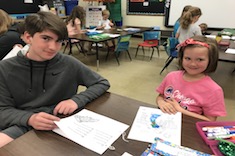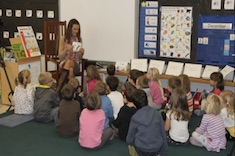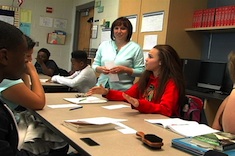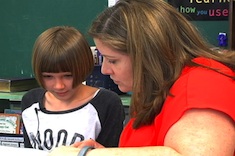When I taught fourth grade in a kindergarten through fourth-grade building, it was nothing to create an activity that involved lower grades. I strongly believed then as I do now that having students work with younger students is beneficial to both groups.
Moving to middle school, I lost the ease of having my students interact with younger grades. My seventh graders could certainly collaborate with the sixth graders across the hall, but it simply isn’t the same. For this reason alone, I am grateful for the Kindergarten Poetry Project that my grade has been doing with the kindergarten in the district for the past 13 years.
Gathering Information
In January every year the principal at the kindergarten building sends us over a Google Sheet with all kindergarten students listed on it by homeroom. We then share a set of questions with all kindergarten teachers that they complete for their students. The questions have changed over the past few years, but essentially, we’re trying to learn a bit about each child—their favorite things, who is in their family, what they look like, and so on. The teachers send us back these forms in March, I make a copy of every sheet in case the originals get lost, and we’re ready to get to work.
Finding Partners
Taking the Google Sheet the principal sent over for us, my colleague and I take the seventh graders by homeroom and assign them to a kindergarten homeroom as much as we can. This makes it easier for everyone at the end of the project when we go to celebrate with our kindergarten friends, because my seventh-grade colleagues can stick with their homerooms.
However, sometimes there are more or fewer kids per class in kindergarten than in seventh grade. Last year the kindergarten class was larger than the seventh-grade class by about 15 kids. So 15 seventh graders agreed to do extra work and create books for two kindergarten buddies instead of one. In previous years when there have been fewer of them, we have had two seventh graders make books for one child. It varies. Also, if a seventh grader has a sibling or cousin in kindergarten and they want to be partnered with them, we make sure that happens. Once the seventh graders know who their partner is, we give them the copied interview sheets.
Creating Our Books
Although we study poetry all year long, we do an intensive study in April. After learning about different formats of poems, we create books for our kindergarten buddies. The students make a Google Slide document that is eight pages long. The book they create follows the following format:
- An acrostic poem of their kindergartner’s first and last name
- An “If I Were . . .” poem
- A poem filled with onomatopoeia words
- A “Who Am I” or “Five Senses” poem
- A poem about the kindergarten student’s birthday month
- A diamante poem
- A limerick
- A bio poem about the seventh grader
We have to remind the students at the beginning to make sure to use the information they’ve learned about their student to create the poems. Do they love tractors? Maybe the onomatopoeia poem could be about the sounds of a tractor or farm. Each page from one to seven needs to have a coloring image that fits that poem’s topic. So, if the seventh grader made a diamante poem about basketball and soccer, they search Google Images for coloring images of those sports and insert an image on that page. The last page is a photo of the seventh grader.
We finish the book in a week, teaching minilessons on two pages a day and using workshop time to create the poems. Kids share their poems with their classmates at the end of each class and begin to get excited about meeting their partners in just a few weeks. I print off the slide presentations, and we bind them simply with two holes punched on the left side of the book and colorful yarn tied in the holes to keep it together. You can view the poetry book seventh grader Estella created by clicking here.
Time to Celebrate
One morning in May, the entire seventh grade loads up on buses and heads across town to meet our partners, books in hand. This is where the planning to keep homerooms with their homeroom teachers as much as possible makes it easier for organizational purposes. We divide up into the kindergarten homerooms, and kindergarten teachers call out their students. Seventh graders greet them, sometimes shyly, sometimes exuberantly, and they find spots all around the classroom to share their books. Typically the seventh graders read through the book once, and then they spend time talking while their kindergarten buddy colors the images they put into their book.
After about 30 minutes, we find a good stopping spot and wave goodbye to our new friends. The ride back to school is filled with seventh graders telling stories about how their kindergarten student wouldn’t speak, or the one who wouldn’t stop talking. There are always gleeful shouts to me about the kid who pulled out picture books for the older child to read to them, or a seventh grader will say, “Mrs. S., they love books. Hope they get you!”
However, by far my favorite thing about this project is the fact that all kids feel successful and filled with joy after giving to someone younger than them. Yes, they learned more about reading and writing poetry, but to me the chance to make something with the goal of giving to others, not just for a grade, is a lesson they all benefit from.










